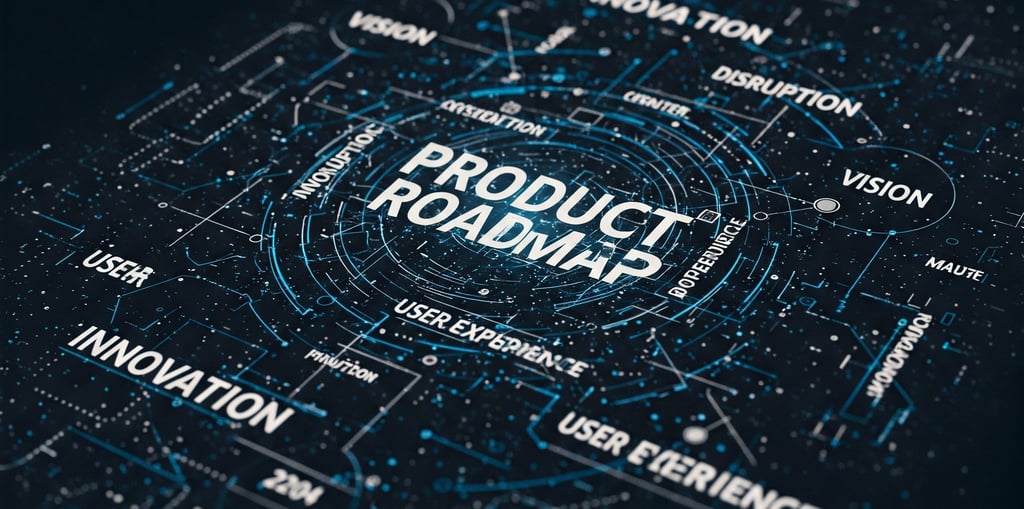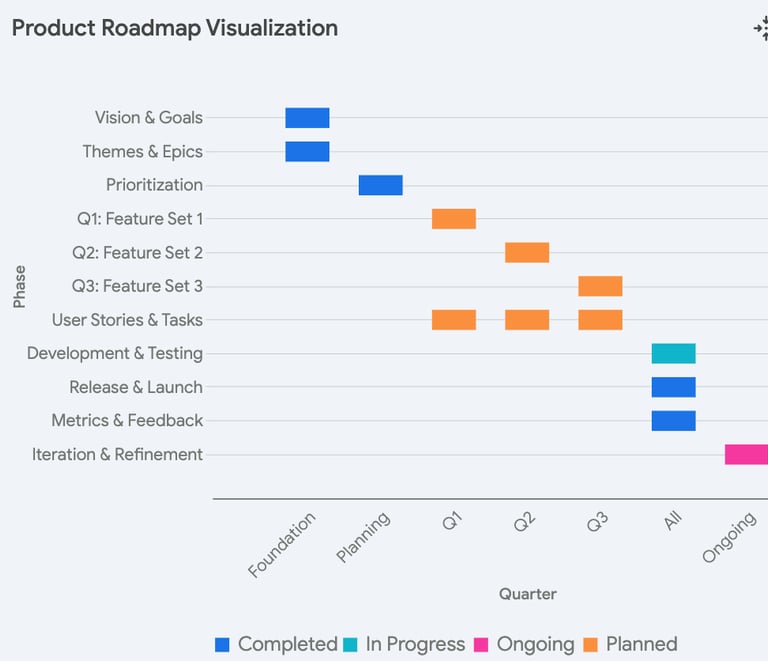Product Roadmap
Charting Your Course...
PRODUCT MANAGEMENT
4 min read


Understanding the Product Roadmap.. Charting the Course
Imagine setting sail on a vast ocean without a map or compass. That's what building a product without a roadmap feels like – chaotic, directionless, and likely to run aground. A product roadmap is your strategic navigation tool, a visual and communicative plan that outlines the direction of your product and how you intend to get there. It's more than just a list of features; it's a living document that aligns your team, stakeholders, and customers around a shared vision and strategy. In this digest, we'll delve into the intricacies of product roadmaps, exploring their purpose, components, and how to create one that drives success.
At its heart, a product roadmap is a high-level visual summary that communicates the product's direction and progress over time. It articulates why you're building something, what you plan to build, and when you aim to deliver it (though the "when" is often expressed in relative terms like quarters or phases, rather than specific dates).
Why Roadmaps Matter:
Alignment: Roadmaps ensure everyone – from engineering to marketing to sales – is on the same page regarding product priorities and timelines. This prevents wasted effort and conflicting priorities.
Communication: A well-crafted roadmap serves as a powerful communication tool for stakeholders, providing transparency into the product's evolution and justifying investment decisions.
Strategic Focus: Roadmaps force you to think strategically about your product. They help you connect individual features and initiatives to overarching business goals and customer needs.
Prioritization: The process of creating a roadmap requires you to make tough choices about what to build and when. This encourages rigorous prioritization based on impact, effort, and dependencies.
Expectation Management: By outlining the product's trajectory, roadmaps help manage expectations among stakeholders and customers. They provide a realistic view of what's coming and when.
Short-Term vs. Long-Term Roadmaps:
Product roadmaps exist on a spectrum of time horizons. Understanding the difference between short-term and long-term roadmaps is crucial for effective planning and communication.
Short-Term Roadmaps (e.g., Quarterly Roadmaps): These roadmaps focus on the immediate future, typically the next quarter or two. They are highly detailed, outlining specific features, tasks, and deadlines. Short-term roadmaps are essential for execution and keeping the team aligned on current priorities.
Long-Term Roadmaps (e.g., Annual or Multi-Year Roadmaps): These roadmaps paint a broader picture of the product's evolution over a longer timeframe. They focus on strategic themes, high-level goals, and potential future directions. Long-term roadmaps are valuable for communicating the product vision to stakeholders and guiding long-term investment decisions.
Let's consider a hypothetical product: a project management software called "ProjectZen."
Short-Term Roadmap (Next Quarter):
Theme: Enhanced Collaboration
Initiative: Implement real-time co-editing of tasks and documents.
Initiative: Integrate with Slack for notifications and updates.
Initiative: Improve commenting and discussion features within tasks.
Long-Term Roadmap (Next Year):
Theme: AI-Powered Productivity
Goal: Introduce AI-powered task prioritization and scheduling.
Goal: Develop intelligent reporting and analytics dashboards.
Goal: Explore integrations with other AI-driven productivity tools
Tracking Roadmap Progress:
A roadmap isn't a static document; it's a living plan that needs to be continuously monitored and updated. Tracking progress against your roadmap is essential for ensuring you're on track to achieve your goals and for identifying potential roadblocks.
Regular Reviews: Schedule regular roadmap review meetings (e.g., weekly or bi-weekly) with the product team to discuss progress, address challenges, and make necessary adjustments.
Key Performance Indicators (KPIs): Define KPIs that align with your roadmap goals. For example, if your roadmap includes a goal to increase user engagement, track metrics like daily active users, session duration, and feature usage.
Visual Dashboards: Use visual dashboards to track progress against your roadmap. These dashboards should display key metrics, milestones, and any potential risks or delays.
Communication: Keep stakeholders informed about roadmap progress through regular updates and reports. Be transparent about any challenges or changes to the plan.
Common Pitfalls to Avoid:
Treating the Roadmap as a Feature List: A roadmap is not just a list of features. It should articulate the "why" behind each initiative and how it contributes to the overall product vision.
Setting Concrete Deadlines Too Far Out: The further out you go, the more uncertain things become. Avoid setting firm deadlines for long-term initiatives. Instead, focus on themes and goals.
Lack of Collaboration: Roadmaps should be created collaboratively, involving input from various stakeholders, including engineering, marketing, sales, and customers.
Ignoring Feedback: Continuously gather feedback on your roadmap from stakeholders and customers. Use this feedback to refine your plan and ensure it aligns with their needs.
Failing to Adapt: The market and customer needs are constantly evolving. Be prepared to adapt your roadmap as needed to stay competitive and relevant.
Key Takeaways/Actionable Steps:
Define your product vision: This is the guiding star for your roadmap.
Distinguish between short-term and long-term goals: Plan for today and tomorrow
Prioritize ruthlessly: Focus on the initiatives that will have the biggest impact.
Communicate transparently: Keep stakeholders informed about your roadmap and progress.
Be flexible: Adapt your roadmap as needed based on feedback and changing circumstances.
Track your progress: Make sure that you have ways to track your progress and key metrics
References:
Roman Pichler, "Strategize: Product Strategy and Product Roadmap Practices for the Digital Age"
Atlassian. (n.d.). Product roadmap examples. https://www.atlassian.com/software/jira/guides/product-management/product-roadmaps
ProductPlan. (n.d.). What is a product roadmap? https://www.productplan.com/learn/product-roadmap/


